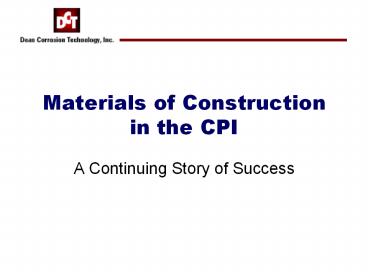Materials of Construction in the CPI - PowerPoint PPT Presentation
1 / 36
Title:
Materials of Construction in the CPI
Description:
Materials of Construction in the CPI A Continuing Story of Success Characteristics of the CPI Major contributor to world economy Producer of a variety of products ... – PowerPoint PPT presentation
Number of Views:25
Avg rating:3.0/5.0
Title: Materials of Construction in the CPI
1
Materials of Construction in the CPI
- A Continuing Story of Success
2
Characteristics of the CPI
- Major contributor to world economy
- Producer of a variety of products
- Produces key components for many industries
- 200 years and growing
3
Chemical Processes - Conditions
- Extreme temperature range 250 to 1400C (LH2,
POX ) - Extreme pressure range vacuum to 4000 psi (TDA
distillation, Urea synthesis) - Large volumes of materials 1 million gallons or
more
4
Characteristics of Chemicals Produced
- Toxic (HCN, H2S)
- Corrosive (HF, HCl, H2SO4, NaOH)
- Flammable (Propane, Benzene)
- Explosive (DNT, NH4NO3)
- Carcinogenic
5
CPI Operations
- Raw materials handling
- Unit operations
- Storage
- Shipment
- Utilities
6
Containment is Vital
- Prevent leaks
- Secondary containment of leak
- Remediation of area affected
- Replacement of defective parts
- Disposal of contaminated product
7
Materials of Construction
- We rely upon M/C for containment
- Very few loss of containment incidents from M/C
failures - Reliability has increased dramatically in the
last 40 years
8
Question How has industry managed to achieve
this in view of the difficult conditions and cost
pressures?Answer (Later)
9
Example H2SO4 in Nitration Process
- Nitration of toluene
- C7H8 2HNO3 ? C7H6(NO2)2 2H2O
- Sulfuric Acid ties up H2O
- H2O H2SO4 ? H2SO4H2O
10
Nitration of Toluene
- Dinitrotoluene, DNT, is important urethane
intermediate - Sulfuric acid regeneration is key to process
economics - Thermal regeneration used
- Problem How to contain hot acid?
11
Chemico Process
- Uses hot flue gas in countercurrent exchange
- Acid brick membrane
- High silicon iron (Duriron) or high silicon
nickel (Hastelloy D) fire tubes
12
(No Transcript)
13
Problems with Chemico Process
- Tubes often fracture brittle material thermal
shock - Brick lining is difficult to maintain
- Process is inefficient
- Acid mist in exit gas pollutes
14
Chemetics Process
- 5 Stage vacuum evaporation process
- Glass lined vessels
- Tantalum heater tubes (steam)
- Venturi steam jet barometric condenser vacuum
system
15
(No Transcript)
16
Problems with Chemetics Process
- Corrosion of expansion bellows (321SSTeflon
lining) - Corrosion of venturi expander (Alloy 20Cb3
general thinning)
17
(No Transcript)
18
(No Transcript)
19
(No Transcript)
20
(No Transcript)
21
Solution to Chemetics Problems
- Upgrade expansion bellows to Alloy 20Cb3
- Upgrade venturi expander to Hastelloy B-2
22
Storage Tanks for Acid
- Vertical cylindrical tanks
- Carbon steel construction
- Required to hold 72, 93, and 98 sulfuric acid
23
Corrosion of Steel in Acid
- 93 and 98 acid H2SO4
Fe ? FeSO4(s) H2(g) - 72 acid
- H2SO4H2O Fe ? FeSO4H2O(s) H2(g)
- Reactions are very fast
24
(No Transcript)
25
Conclusions from Rate Studies
- Corrosion rates are reasonable for all three
acids - Corrosion allowance required
- Corrosion rate determined by dissolution of FeSO4
- Issue of velocity accelerated corrosion
- Issue of corrosion product wedging
26
Design Issues for Acid Tanks
- Inlet and exit nozzles
- Impingement onto walls of tank
- Hydrogen grooving
- Eliminate crevices
- Sunny side corrosion
- Prevent acid dilution!
27
(No Transcript)
28
(No Transcript)
29
Sulfuric Acid Pipelines
- Carbon steel heavy wall
- Limit velocity 2 ft/sec max
- Limit temperature
- Use long radius elbows
- Minimize flow disturbances from welds
30
Problems with C Steel Pipelines
- Maximum velocity limits production
- Weld roughness causes damage
- Accelerated corrosion at inlet end
31
(No Transcript)
32
Corrosion Rate Prediction
- Dissolution of iron sulfate
- Mass transfer analogy (Chilton, Colburn)
- Prediction confirmed by measurements
- CR F(T,V,?,?,d)w Fe
33
Upgrades
- For 72, use Alloy 20Cb3
- For 93 and 98, use 316L SS
- Reliability improved
- Iron content of acid reduced
34
Answer to Question
- Designs that incorporate features to prevent
problems - Using industry standards (NACE, API)
- Maintaining awareness of industry experience
(MTI) - Inspection and upgrade to eliminate problems
35
Conclusions
- Higher cost materials are often justified by
improved safety and reliability - Newer materials solve traditional problems
- Designs can minimize materials problems
36
THANK YOU!
- References
- Shreve,N., The Chemical Process
Industries,McGraw-Hill, 1956 - Dillon,C.P.M.S.for H.C., Vol.1 Sulfuric Acid,
MTI, 1997 - NACE RP02-94 Design, Fabrication and Inspection
etc. 1994































